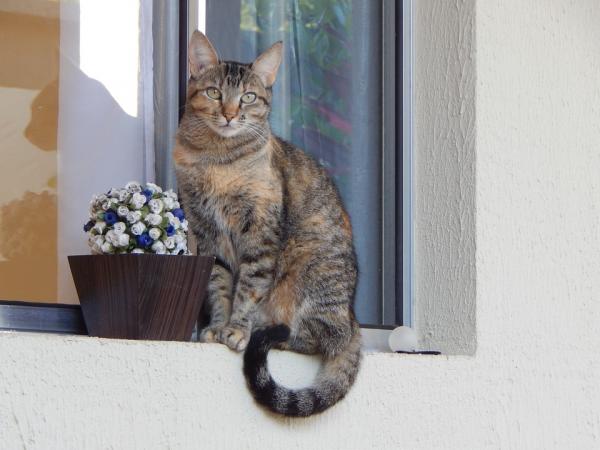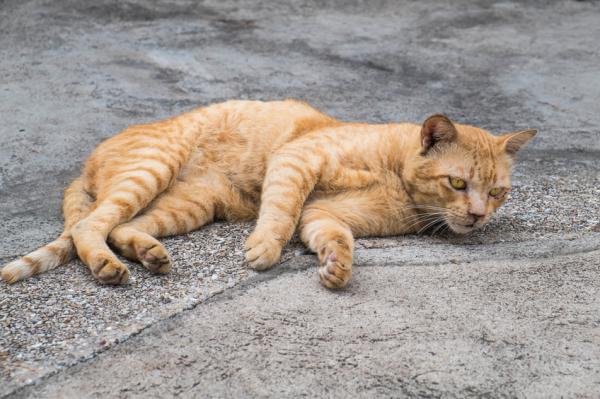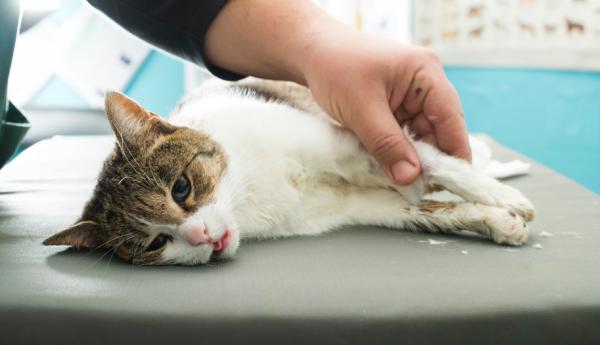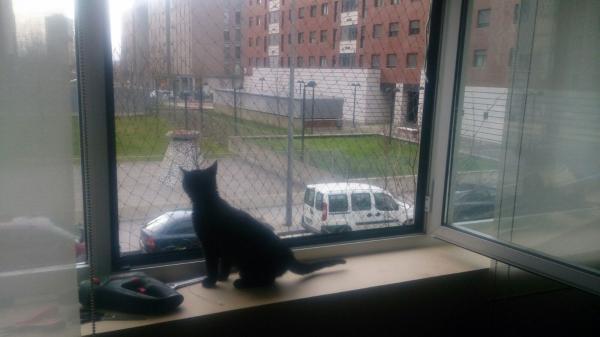My cat has fallen out the window

We’ve all heard thousands of times that cats always fall on their feet, and maybe that’s why some do not give more importance to the fact that their pussycat spends hours on the window sill of a fourth floor, stalking the pigeons But these years of coexistence with cats in buildings, and too many deadly accidents, take away our reason and makes us see that, although the felines can land on their pads, that is not synonymous with survival.
Des, we know that this terrible event is too frequent and serious, and we want to offer you a series of tips to know how to act. We will explain what are the first aid if your cat has fallen out the window.
Pick up a cat that has fallen down the balcony
If we can realize in time that our cat has fallen on the balcony, or out the window, it is essential to pick it up before it can get up and flee in terror before the noise and the completely strange environment. Wounded cats seek to hide in quiet places, even more so if the area in which they find themselves is totally unknown, and they obey the instinct to be safe from anyone who can take advantage of their situation of vulnerability.
Logically, before we get down to the street, our pussycat will probably have sought refuge, and it is very common to find posters in all veterinary clinics of people looking for their cat, who fell through the window days before. The theory is always relatively simple, and the practice, especially talking about cats, is another story, but it is always easier to “skip the recommendations” if we have any reference.
– Continues on the sidewalk, can not move or is scared
We will have to gather strength and cold blood and run to find his rigid carrier, first, to go down for him. If we do not have a carrier, we will go down with a towel.
When we arrive, we can find the dorsal decubitus (lying on one side), in which case, we will have to pass both hands with the back glued to the sidewalk, and the palm in contact with your body. In this position, you must enter the carrier, Without bending or twisting any limb, nor your neck, just as bakers put the bread in the oven. The help is always essential, and more in this case, because the ideal is that someone has disassembled the upper part of the carrier to be able to deposit it without hardly moving it, and close later.
If we do not have a carrier, we can, with the help of another person, create a rigid surface with the towel, tightening it with force, to transfer it to the nearest veterinary clinic.
If he is staggering, but still standing, an option that may be somewhat annoying, but the least stressful for him considering the situation, is to grab him carefully by the skin of the interscapular area (nape) as his mother did when he Take them from one place to another, and put them in the carrier. Our first intention is always to take it by the thorax, but in this case not very advisable.
– You do not find your cat and you do not know where it is
After falling over the balcony, a cat may present slight injuries, in which case it may have traveled a considerable distance trying to find A hiding place. Some suffer a run over in this flight, and others just wait under cars, or in bushes, any place where they see little.
If after checking all possible nearby hiding places we do not locate it, we must follow the steps to find a lost cat: notify all the veterinary clinics and animal shelters nearby (they always help posters with the color picture of the cat near our house) and Wait for the night to go out and call him. Our voice is more easily recognizable without so much noise from people and cars and tranquility encourages them to leave.
Although we apparently find him “healthy”, we must introduce him into the carrier delicately and take him to a veterinary clinic to look for some of the typical pathologies of “the parachutist cat syndrome”.

While you wait to take him to the vet
Sometimes, when there are no apparent injuries, we see our cat so scared that we take it home, and we wait to contact our veterinarian to give us some instructions if we are outside the clinic opening hours and they will take some time go in Some tips that you can give us:
- We must leave our cat in the carrier in a quiet place, with little light and stimuli.
- Do not manipulate or put a cushion or mat.
- Place the carrier in a light inclined plane, so that the cat is with the head and the thorax above the abdomen.
- Never give water or food. If it has been a few hours since you fell through the window, it is normal that your first intention is to feed the cat, but your palate may be open as a result of the fall, and water or food can pass into the airway causing aspiration pneumonia . It will only be a couple of hours more.
How to know if the cat is getting worse?
If we have picked it up or found it after falling off the relatively stable balcony, but everything gets complicated, we can notice it by:
- Ortopneic position (stretches the neck and looks up, trying to get more oxygen).
- Loss of consciousness that he retained.
- If we open the door of the carrier and we see that his pupils are dilated and fixed, and the color of his gums is white or bluish gray.
- Finally, if there have already been too serious injuries, or we have arrived late, we will hear serious vocalizations, and observe the typical “puffs” that precede death. In these cases there is usually no time for observation, or to get anywhere where it can be attended.
Once at the vet
After falling through the window our cat can present a series of injuries, of greater or lesser severity, that are included within the “parachutist cat syndrome”. If you have had time to react and be able to turn to fall on your feet, you will have done so on the four outstretched extremities, and the back arched to minimize the force of the impact. But the rebound effect, more or less intense depending on the distance from which it has fallen, brings a series of consequences:
- Jaw break: When bouncing after the fall, it is common to find the broken mandibular symphysis.
- Fissure on the hard or soft palate: Hence, it is better not to offer anything even if it looks good. This sutures must be repaired, and sometimes fed to the cat through a nasogastric tube until the palate is completely closed.
- Fractures in metacarpals-metatarsals and phalanges: The fingers of all the extremities usually take the worst part.
- Fractures of the femur, tibia and hip: The posterior limb, more flexible, cushions the impact of the rebound more than the previous one, so finding fractures or fissures (tears without displacement) is very common. Sometimes they go unnoticed and weld alone, finding themselves afterwards as a casual finding in another exploration.
- Diaphragmatic hernias: The impact causes a rupture of the diaphragm that separates the thorax from the abdomen and the abdominal contents (intestinal loops, liver, spleen.), Goes to the thorax preventing the lungs from expanding. Sometimes it is very evident, the cat breathes badly and there is thinning of the abdomen, but at other times it is a small hole through which just a few small bowel strands are cast and only becomes evident when handling the cat or after the tests.
- Hepatic and bladder rupture: If the bladder of the urine was full on impact, it has a good chance of being broken by tension. The liver can also suffer contusions or ruptures, as can the abdominal aorta, which triggers a generally fatal internal hemorrhage.
What tests will my cat do after falling down the balcony?
Each veterinarian will propose a series of tests, according to the case and the physical exploration of the cat, but in general there are several common things:
- Stabilize you before you start to explore: Oxygenating and sedating is almost mandatory if our cat has difficulty breathing, even if it is mild. If you do not tolerate the mask or are very nervous, which aggravates the dyspnea picture, a mild and relatively safe sedative, such as midazolam, may be required to continue. The plates require moving the cat and for this we need to be sure that it adequately ventilates. Normally, this moment is used to catheterize a central vein. Analgesia with some opioid may be delayed if they fear it will depress breathing, but there are many other pain-relieving drugs available.
- Basic exploration: the color of the mucous membranes, auscultation, temperature, abdominal palpation or pulse provide a lot of information to the veterinarian to continue deciding tests.
- Diagnostic imaging: It may be necessary to postpone it for a few hours until the cat is stabilized, but the plaque makes us see the diaphragmatic hernia and the ultrasound shows us free fluid in the abdomen (urine, blood), the integrity of the liver and spleen, and the bladder of the urine . If the cat is sedated and does not have an ultrasound machine, they can choose to probe the bladder to check if urine is coming out of the tube. If it comes out, it indicates that the urine is being stored in an intact bladder, and it is assumed that it has not been broken, but it will be verified after a few hours with a plate, in which a contrast can be made.
It must be borne in mind that a bladder or liver rupture, and dyspnea (due to diaphragmatic hernia, lung contusion, etc.), are critical and very unfavorable situations in which it can almost never be done, neither by the owner nor by the vet. Many cats manage to overcome the stabilization to be operated on, but they die in the surgery of the diaphragmatic hernia or in the postoperative period due to complications such as the one that means rebalancing pressures in the thorax when removing the mass that was occupying that space.

Back home, with bruises
If we have been lucky, and have been discharged, what usually happens after a minimum of 24 – 36 hours under observation, you may only have a bone fracture that does not require surgery, and a good pulmonary contusion. In this case, they will ask us to rest as much as possible, sometimes in a cage, and to monitor their urine and feces (you may need a lubricant to evacuate better, such as olive oil or liquid paraffin). his breathing and the color of his mucous membranes.
The daily intake of analgesics and in some cases, Antibiotics To avoid contamination of a bone fracture and a prudent time, they will lead to a complete recovery.
Prevention, before healing
Remember that when our cat falls once through the window or balcony of our apartment, it is an accident. We will have left the window open, they have not yet been castrated and have smelled congeners, they have been stalking the birds, or simply, something caught their attention there.
But a second and even the third time, as you see many times, is already a case of carelessness or negligence on our part. Obviously if there are children at home, we will have to opt for intermediate solutions, in case they decide to open the window without checking where the cat is: mosquito nets, aluminum fabrics. There are many methods of containment that allow the passage of light and air, and they are not expensive when it comes to saving a life.
Un necklace with identification plate It is not always liked by a cat, but we can always opt for the microchip, although it is not mandatory for cats in many communities. Thanks to him, many owners locate their parachutist cats.
But after falling once, it will not fall anymore.
In that aspect they are a little human, trip twice, and those that are needed, with the same window open. The saying that curiosity killed the cat, takes a long time in the proverb for something.
Sometimes we leave the window in a depressed position convinced that there is no danger, but many cats die hanged or asphyxiated in the case when trying to sneak out when they get caught, something that we do not believe, until it happens to us. And it happens very often. Remember, if you think it impossible for your cat to do something. Without a doubt, it will.

This article is merely informative, in .com we do not have the faculty to prescribe veterinary treatments or make any kind of diagnosis. We invite you to take your pet to the veterinarian in case of any type of condition or discomfort.
If you want to read more articles similar to My cat has fallen out the window, we recommend that you enter in our First Aid section.


